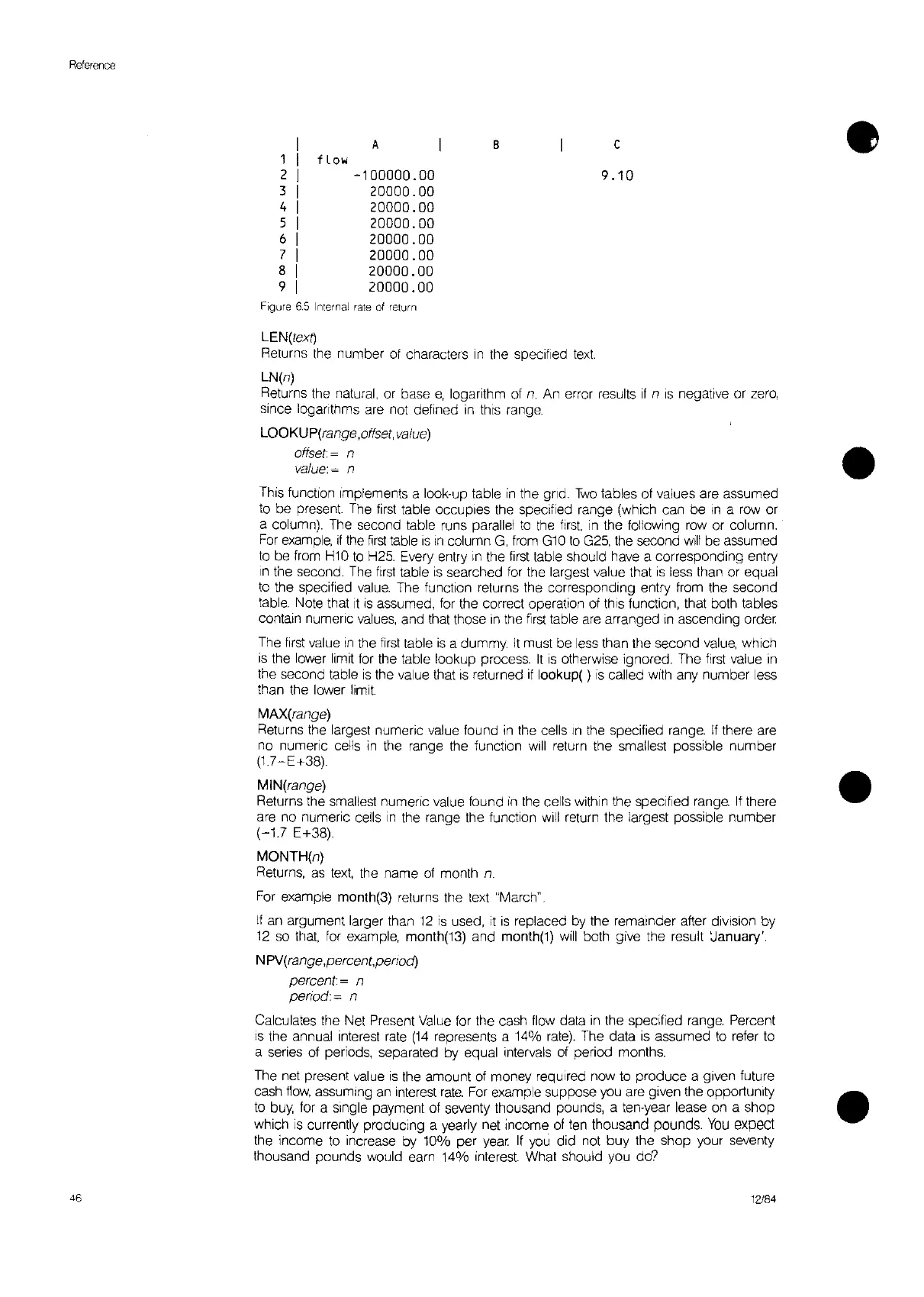Reference
A B
1
fLow
2
-100000.00
3
20000.00
4
20000.00
5
20000.00
6
20000.00
7
20000.00
8
20000.00
9
20000.00
Figure
6.5
Internal
rate
of
return
c
9.10
•
•
•
46
LEN(text)
Returns
the
number
of
characters
In
the specified text
LN(n)
Returns the natural, or base
e,
logarithm
of
n.
An
error results
If
n
IS
negative or
zero,
since logarithms are not defined
in
this range
LOOKUP(range,oltset,value)
altset:~
n •
value:~
n
This function Implements a look-up table
in
the grid.
Two
tables of values are assumed
to
be present The
first
table occupies the specified range (which can be
In
a
row
or
a column). The second table runs parallel
to
the
first
in
the following
row
or column.
For
example,
if
the
first
table
IS
In
column
G,
from
G10
to
G25,
the second
will
be assumed
to
be from
H10
to
H25.
Every entry
In
the first table should have a corresponding entry
In
the second. The
first
table
IS
searched
for
the largest value that
is
less than or equal
to
the specified
value.
The function returns the corresponding entry from the second
table. Note that
It
IS
assumed,
for
the correct operation of
thiS
function, that both tables
contain
numeric
values,
and that those
in
the
first
table
are
arranged
In
ascending order
The
first
value
in
the
first
table
is
a dummy.
It
must be
less
than the second
value,
which
IS
the lower limit for the table lookup process.
It
is
otherwise ignored. The
first
value
in
the second table
is
the value that
IS
returned
if
lookup( )
is
called with any number less
than the lower limit
MAX(range)
Returns the largest numeric value found
in
the cells
In
the specified range.
If
there are
no
numeriC cells
in
the range the function
will
return the smallest possible number
(1.7
-E
+38).
MIN(range)
Returns the smallest numeric value found
in
the
cells within the speCified range
If
there
are no numeric cells
,n
the range the function
will
return the largest possible number
(-17
E+38).
MONTH(n)
Returns,
as
text,
the name
of
month
n.
For
example month(3) returns the
text
"March".
If
an argument larger than
12
is
used,
it
is
replaced
by
the remainder after diVIsion by
12
so
that,
for
example, month(13) and month(1)
will
both give the result
~anuary'.
NPV(range,percent,penad)
percent:~
n
periad:~
n
Calculates the Net Present
Value
for
the cash
flow
data
in
the specified range. Percent
is
the annual interest
rate
(14
represents a 14%
rate).
The data
is
assumed
to
refer
to
a series of periods, separated by equal intervals of period months.
The net present value
is
the amount of money reqUired now
to
produce a given future
cash
flow,
assuming an Interest
rate.
For
example suppose you are given the opportunity
to
buy,
for a
Single
payment of seventy thousand pounds, a ten-year lease
on
a shop
which
is
currently producing a yearly net income
of
ten
thousand pounds.
You
expect
the income
to
increase by 10% per year
If
you
did not buy the shop your seventy
thousand pounds would earn 14% interest What should you do?
12/84

